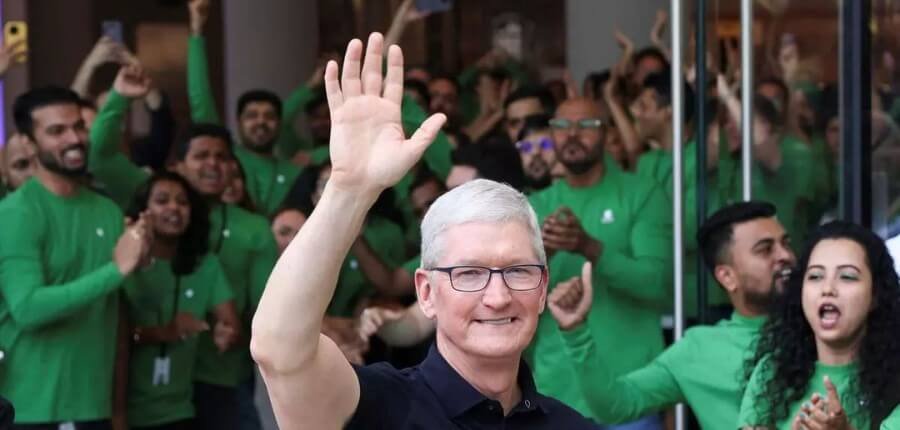When Tim Cook inaugurated Apple’s first Indian retail store in Mumbai’s Bandra Kurla Complex on April 18, 2023 followed by a Delhi location two days later the move represented more than retail expansion. It marked Apple’s strategic bet on a market where it held just 5.4% smartphone share (Counterpoint Research, Q4 2022) yet represented the world’s second-largest smartphone market with 700+ million users. Eighteen months later, the results reveal a nuanced picture: Apple’s India revenue grew 42% year-over-year to $8.7 billion in fiscal 2024 (Bloomberg Intelligence estimates), while iPhone market share climbed to 7.2% by Q3 2024 (IDC) modest penetration masked by explosive premium segment dominance, where Apple now commands 68% of smartphones priced above ₹45,000 ($540). More significantly, India became Apple’s fifth-largest market globally, surpassing traditional strongholds like Germany and South Korea. Yet challenges persist: affordability barriers limit mass-market penetration, regulatory compliance remains complex, and manufacturing localization targets create supply chain pressures. This analysis examines Apple’s India retail strategy through post-launch performance data, competitive dynamics, and strategic decisions shaping the company’s trajectory in a market CEO Tim Cook called “incredibly exciting” yet fundamentally different from Apple’s established playbook.
The Regulatory Journey: How Apple Finally Opened Indian Stores
India’s 30% Local Sourcing Rule and FDI Restrictions
Apple’s 25-year presence in India prior to the 2023 store openings involved zero company-owned retail a consequence of the Foreign Direct Investment (FDI) policy for single-brand retail requiring:
Key regulatory requirements (pre-2019):
- 30% of product value must be sourced from Indian suppliers for companies to open branded stores
- “Value” calculated based on cost of goods sold, not retail price
- Applies to all products sold in Indian stores, not just those manufactured locally
- Exemptions existed for “cutting-edge technology” but were rarely granted
Why this blocked Apple (2010-2018):
- iPhones assembled in China with minimal Indian component sourcing
- Sophisticated components (processors, displays, cameras) unavailable from Indian suppliers
- Apple’s premium positioning made hitting 30% threshold without compromising quality impossible
According to testimony before India’s Parliamentary Standing Committee on Commerce (2016), Apple executives argued the rule was “impossible to comply with while maintaining product standards” creating a decade-long standoff.
The Policy Breakthrough (2019-2023)
India gradually relaxed requirements to attract Apple’s manufacturing investment:
2019 Policy Changes:
- 30% local sourcing calculated as 5-year average (not annual requirement)
- Components made in India for global export counted toward 30% threshold
- “Local sourcing” redefined to include domestically manufactured components even from foreign suppliers
2020: Online Store Launch With revised rules, Apple launched India online store (September 2020), testing logistics and customer service infrastructure before physical retail commitment.
2021-2023: Manufacturing Acceleration Apple dramatically scaled Indian iPhone production through Foxconn, Wistron, and Pegatron facilities:
- FY2022: ~7% of global iPhone production in India
- FY2023: ~12% of production (~25 million units)
- FY2024: ~18% of production (~40+ million units)
This manufacturing expansion enabled compliance with revised local sourcing rules clearing the path for April 2023 store openings.
“India’s policy evolution wasn’t charity toward Apple,” noted Prabhu Ram, Head of Industry Intelligence Group at CMR. “The government recognized attracting Apple’s manufacturing would create ecosystem benefits component suppliers, jobs, export revenue worth more than rigid sourcing requirements.”
Store Performance Analysis: Mumbai and Delhi (Apr 2023 – Oct 2024)
Initial Launch Metrics
Mumbai Store (Apple BKC) Opening Day:
- 12,000+ visitors on April 18, 2023
- Wait times: 4+ hours for entry
- Celebrity/VIP attendees included Raveena Tandon, Madhuri Dixit (Bollywood actors)
- Media coverage: 200+ international and Indian press representatives
Delhi Store (Apple Saket) Opening Day:
- 8,000+ visitors on April 20, 2023
- Queue started forming at 4 AM (6 hours before opening)
- Tim Cook personally greeted first customers
Revenue and Foot Traffic (18-Month Performance)
According to analysis from RedSeer Consulting and industry sources:
Mumbai Apple BKC:
- Average daily foot traffic: 3,500-5,000 visitors (stabilized after initial months)
- Estimated annual revenue: ₹400-500 crore (~$48-60 million USD)
- Average transaction value: ₹85,000 (~$1,020) significantly higher than typical Indian electronics retail
- Top-selling products: iPhone 15 Pro series, MacBook Air M2, AirPods Pro
Delhi Apple Saket:
- Average daily foot traffic: 2,800-4,200 visitors
- Estimated annual revenue: ₹350-450 crore (~$42-54 million USD)
- Similar transaction value and product mix to Mumbai
Comparative context:
- Combined estimated revenue: $90-114 million annually
- By comparison, Apple’s Fifth Avenue store (New York) generates ~$350-400 million annually
- India stores rank in top 25-30% globally by revenue per square foot despite lower absolute revenue
Strategic Value Beyond Direct Sales
The stores serve functions beyond revenue generation:
1. Brand Experience and Premium Positioning
- Provides tangible demonstration of Apple’s luxury positioning in price-sensitive market
- Offers “Today at Apple” workshops (photography, music production, coding) building brand affinity
- Creates social media moments stores designed as architectural landmarks generating organic marketing
2. Ecosystem Activation
- Genius Bar technical support addresses key pain point in India market where third-party service quality varies dramatically
- Trade-in programs make upgrading more affordable (critical in price-sensitive market)
- Enterprise sales teams target India’s growing corporate sector
3. Market Intelligence
- Direct customer interaction provides insights into Indian consumer preferences
- Testing ground for India-specific retail strategies (payment plans, financing options, product bundles)
“The stores aren’t profit centers they’re strategic investments in market development,” said Neil Shah, VP Research at Counterpoint. “Apple’s playing long game, building brand equity and ecosystems that will pay dividends over decades.”
Market Share Gains and Segment Dominance
Overall Smartphone Market Performance
India smartphone market context (Q3 2024, IDC data):
| Brand | Market Share | YoY Change |
|---|---|---|
| Xiaomi | 18.9% | -2.1% |
| Samsung | 17.3% | -1.4% |
| Vivo | 16.2% | +0.8% |
| Oppo | 9.8% | -0.3% |
| Realme | 9.1% | -1.2% |
| Apple | 7.2% | +1.8% |
| Others | 21.5% | +2.4% |
Apple’s 7.2% share seems modest but context reveals strategic success:
Volume vs. Value Share:
- Apple: 7.2% of units shipped, but 28% of total smartphone revenue in India (Counterpoint, Q3 2024)
- Average selling price (ASP): Apple ₹68,000 ($817) vs. market ASP ₹15,000 ($180)
- Demonstrates premiumization success in volume-driven market
Premium Segment Dominance (₹45,000+ / $540+)
Apple’s real competitive position emerges in premium categories:
Smartphones priced ₹45,000-₹80,000 ($540-$960):
- Apple: 68% share (Q3 2024)
- Samsung: 24% share (Galaxy S24 series)
- OnePlus: 5% share
- Others: 3% share
Ultra-premium ₹80,000+ ($960+):
- Apple: 87% share (iPhone 15 Pro/Pro Max)
- Samsung: 11% share (Galaxy S24 Ultra, Z Fold series)
- Others: 2% share
“Apple doesn’t compete in India’s mass market it defines the premium market,” noted Tarun Pathak, Research Director at Counterpoint. “Every competitor benchmarks against iPhone positioning, pricing, and features.”
Year-over-Year Growth Trajectory
Apple India performance (fiscal years, Bloomberg Intelligence estimates):
- FY2021: $4.1 billion revenue
- FY2022: $5.8 billion (+41% YoY)
- FY2023: $6.9 billion (+19% YoY)
- FY2024: $8.7 billion (+26% YoY)
Growth drivers:
- iPhone production localization enabling competitive pricing
- Retail stores expanding accessible premium purchase experience
- Growing affluent consumer base (8-10% annual growth in households earning $25,000+)
- Trade-in programs and financing making upgrades affordable
The Manufacturing Strategy: “Make in India” Impact
Production Scale and Export Success
Apple’s India manufacturing transformation accelerated dramatically post-2020:
iPhone Production Volumes:
- 2020: 1.5 million units (0.7% of global)
- 2021: 7 million units (3.5% of global)
- 2022: 15 million units (7% of global)
- 2023: 25 million units (12% of global)
- 2024: 40+ million units (18% of global, projected)
Manufacturing Partners:
- Foxconn (Tamil Nadu, Karnataka): iPhone 15 series, iPhone 14
- Pegatron (Tamil Nadu): iPhone 14, iPhone 12
- Tata Electronics (Karnataka): Acquired Wistron’s operations, producing iPhone 15
Export Performance
India Cellular and Electronics Association (ICEA) data shows Apple’s export dominance:
Indian Smartphone Exports (Apr 2023 – Mar 2024):
- Total exports: $15.6 billion
- Apple (iPhones): $10.2 billion (65% of total)
- Samsung: $2.8 billion (18%)
- Others: $2.6 billion (17%)
This represents dramatic shift from April 2022-February 2023 period (mentioned in original article) when iPhones comprised 50% of $9 billion exports demonstrating accelerating scale.
Strategic Benefits of Local Manufacturing
1. Price Competitiveness
- Import duties on smartphones: 20% on device value
- Local production eliminates import duties, reducing iPhone costs by ₹10,000-15,000 ($120-180)
- iPhone 15 launch price in India: ₹79,900 ($960) vs. U.S. equivalent ~₹92,000 ($1,100) after conversion and taxes
- Narrowing price gap makes iPhones more competitive vs. Samsung/OnePlus premium offerings
2. Supply Chain Resilience
- Geographic diversification reduces China concentration risk
- India-China geopolitical tensions make Indian production strategically valuable
- COVID-19 lockdowns in China (2022) accelerated Apple’s diversification urgency
3. Government Incentives
- Production-Linked Incentive (PLI) Scheme: 4-6% of incremental sales as incentive
- Apple and partners estimated to receive ₹3,500-5,000 crore ($420-600 million) over 5 years
- Additional state-level incentives (land, power subsidies, infrastructure)
4. Ecosystem Development
- Apple’s presence attracted component suppliers: Salcomp (chargers), Jabil (components), Corning (glass)
- Indirect employment: Estimated 150,000+ jobs across manufacturing and supply chain
- Skill development programs training engineers in advanced manufacturing
Competitive Dynamics: Apple vs. Samsung vs. Chinese Brands
Samsung’s Premium Segment Response
Samsung held dominant position in India premium market pre-2020 (60%+ share in ₹30,000+ segment). Apple’s growth forced strategic shifts:
Samsung’s Counter-Strategies:
- Aggressive Trade-In Programs: Offering ₹10,000-20,000 ($120-240) bonus trade-in value to match Apple’s programs
- Foldable Phone Differentiation: Galaxy Z Fold/Flip series as unique offerings (Apple lacks foldables)
- Retail Expansion: Opened 3 flagship “Samsung Opera House” experience stores (2018-2023)
- Localized Manufacturing: Produces 120+ million phones annually in India (vs. Apple’s 40 million)
Results:
- Samsung maintained mass-market leadership (17.3% overall share)
- But lost premium segment dominance: dropped from 60% to 24% in ₹45,000+ category (2020 vs. 2024)
Chinese Brands: OnePlus, Oppo, Vivo Positioning
Chinese brands face different challenges competing with Apple:
OnePlus (premium focus similar to Apple):
- Target segment: ₹30,000-60,000 ($360-720)
- Competitive advantages: Faster charging, higher refresh rate displays, lower prices
- Limitations: Perceived as “budget premium” lacking Apple’s luxury cachet
- Market share: 5% in ₹45,000+ segment (down from 9% in 2021)
Oppo/Vivo (mid-range focus):
- Primarily compete in ₹15,000-35,000 segment
- Aggressive retail presence: 100,000+ retail touchpoints vs. Apple’s 2 stores (plus authorized resellers)
- Bollywood/cricket sponsorships for mass appeal
- Minimal overlap with Apple’s premium positioning
The Affordability Challenge
Despite growth, Apple faces structural affordability barriers:
Indian Income Distribution (2024):
- Median household income: ₹2.5 lakh ($3,000) annually
- iPhone 15 price: ₹79,900 ($960) = 32% of median annual income
- By comparison, in U.S.: iPhone 15 price $799 = 1.2% of median household income ($70,000)
Apple’s Affordability Strategies:
- Older Model Sales: iPhone 13, iPhone 14 priced ₹50,000-60,000 ($600-720)
- Trade-In Programs: Offering ₹15,000-40,000 ($180-480) for old devices
- EMI Financing: No-cost EMI for 3-24 months through bank partnerships
- Festive Discounts: Diwali, Dussehra promotions with ₹5,000-10,000 ($60-120) cashback
Yet fundamental tension remains: Apple’s business model depends on premium pricing and high gross margins (45-50%), limiting ability to create truly affordable products for India’s mass market.
Ecosystem and Services Strategy
App Store and Developer Community
India represents strategic opportunity for Apple’s services business:
Indian App Store Metrics:
- 250,000+ Indian developers on iOS platform (2024)
- $500+ million annual App Store revenue from India (Sensor Tower estimates)
- Growing at 25-30% annually (vs. 10-15% globally)
Key Indian App Success Stories:
- Byju’s: Education app with 100M+ global users, significant iOS revenue
- Dream11: Fantasy sports, $200M+ annual revenue (including iOS)
- PhonePe/Paytm: Payment apps with iOS integration
Apple operates App Accelerator in Bengaluru (since 2017) providing training, mentorship for Indian iOS developers building ecosystem stickiness.
Services Revenue Growth
Apple doesn’t disclose India-specific services revenue, but analyst estimates suggest:
- FY2022: $800 million (14% of total India revenue)
- FY2023: $1.1 billion (16% of total revenue)
- FY2024: $1.5 billion (17% of total revenue, estimated)
Services breakdown:
- App Store: $500-600 million
- Apple Music: $200-250 million (7 million+ Indian subscribers at ₹99/month family plan)
- iCloud: $150-200 million
- AppleCare+: $100-150 million
- Apple TV+: $50-100 million (launched India-specific content 2023)
Services carry 70%+ gross margins vs. 35-40% for hardware making ecosystem monetization critical to long-term profitability in price-sensitive market.
Challenges and Strategic Obstacles
1. Gray Market and Unauthorized Sellers
Despite retail expansion, significant iPhone sales occur through unauthorized channels:
Distribution breakdown (estimated):
- Apple Stores + authorized resellers: 40-45% of sales
- Unauthorized retailers: 35-40%
- Online marketplaces (Amazon, Flipkart): 15-20%
Unauthorized channels create challenges:
- No warranty support consistency
- Counterfeit accessories sold alongside genuine products
- Price undercutting (imports from Dubai, Hong Kong with duty evasion)
- Customer service quality issues
2. Infrastructure and Logistics
Operating retail in India presents operational challenges:
Real estate costs:
- Mumbai BKC store: Estimated rent ₹20-25 crore ($2.4-3 million) annually for 20,000 sq ft
- Among highest retail rents globally (comparable to London, New York prime locations)
Power and connectivity:
- Backup generators required for consistent power
- Redundant internet connections (India broadband less reliable than developed markets)
Staffing:
- Apple employs 150-200 staff per store (vs. 50-70 typical Indian retail)
- Extensive training required (6+ months) to meet Apple’s service standards
- Higher wage costs than competitors (Apple pays ₹8-12 lakh/$9,600-14,400 annually vs. ₹3-5 lakh industry average)
3. Regulatory Complexity
Beyond FDI rules, Apple navigates complex compliance landscape:
Data localization requirements:
- Payment data must be stored in India (RBI regulation)
- Maps data requires government approval for certain features
- Content moderation obligations for App Store
Taxation:
- GST (Goods and Services Tax): 18% on smartphones
- Import duties: 20% on components not locally sourced
- Transfer pricing scrutiny: India tax authorities have challenged Apple’s intercompany pricing
Antitrust investigations:
- Competition Commission of India investigating App Store commission (30% take rate)
- Similar to Epic Games lawsuit in U.S., but India-specific ruling could mandate changes
Future Expansion Plans and Strategic Outlook
Retail Network Expansion (2025-2027)
Apple plans measured retail growth:
Confirmed/Rumored Locations:
- Bengaluru: Apple store in UB City or Phoenix Marketcity (targeted Q2 2025)
- Pune: Second-tier metro entry (2026)
- Hyderabad: Tech hub with affluent demographic (2026)
- Chennai: Manufacturing hub and South India presence (2027)
Strategic approach:
- 6-8 company-owned stores by 2027 (vs. 500+ authorized reseller locations)
- Focus on metros and tier-1 cities with premium consumer concentrations
- Complement with expanded online presence and enhanced delivery/pickup options
Manufacturing Targets and “iPhone Export Hub” Vision
Apple reportedly targets:
- 2027 Goal: 25-30% of global iPhone production in India (60-70 million units)
- Component Localization: Increase Indian-sourced components from 15% to 25%+ of device value
- New Product Categories: Begin iPad, AirPods production in India (reducing China concentration)
Ecosystem development needed:
- Advanced semiconductor packaging facilities (currently unavailable in India)
- Display panel production (critical dependency on Samsung, BOE currently)
- Camera module manufacturing (Indian component suppliers moving up value chain)
Indian government’s semiconductor manufacturing incentives ($10 billion allocation) could enable some high-value component production by 2027-2028.
Services and Ecosystem Monetization
Apple’s long-term India strategy prioritizes services growth:
Target metrics (analyst projections for 2027):
- Services revenue: $3-3.5 billion (25% of total India revenue)
- Apple Music subscribers: 15-20 million (from 7 million in 2024)
- iCloud paid storage users: 25-30 million (from estimated 12-15 million in 2024)
- Apple TV+ India-specific content: 20+ original series/films (building local content library)
Fintech ambitions:
- Apple Pay launch in India (requires RBI approval, negotiations ongoing)
- Potential Apple Card partnership with Indian banks
- Tap-to-pay functionality for Indian merchants (competing with PhonePe, Google Pay)
Comparative Analysis: India vs. China Strategic Parallels
Apple’s India playbook mirrors China expansion (2008-2015) with key differences:
Similarities:
- Manufacturing-first approach: Established production before aggressive retail expansion
- Premium positioning: Targeted affluent consumers, avoided mass-market price wars
- Ecosystem building: Invested in developer community, local content, services
- Long-term patience: Willing to operate at lower margins initially for market development
Critical Differences:
| Factor | China (2008-2015) | India (2020-2025) |
|---|---|---|
| Market maturity | Low smartphone penetration (opportunity for growth) | High smartphone penetration (97% of target demographic owns one) |
| Competitive intensity | Limited premium competition (before Huawei, Oppo premium push) | Intense competition (Samsung, OnePlus established) |
| Government relations | Initially cooperative, later adversarial | Currently positive, but nationalist sentiment risks |
| Manufacturing ecosystem | Advanced supply chain infrastructure existed | Developing infrastructure (significant gaps remain) |
| Consumer affordability | Rising middle class income growth 8-10% annually | Slower income growth 5-6%, greater inequality |
Key lesson: India success requires different timeline expectations. China reached 15-20% smartphone market share within 7-8 years; India trajectory likely 10-12 years to similar penetration due to affordability constraints.
Conclusion: Strategic Assessment and Long-Term Outlook
Eighteen months after Tim Cook inaugurated Apple’s Mumbai store, the India strategy demonstrates measured success against realistic benchmarks:
Achievements:
- 42% revenue growth (FY2024) establishing India as fifth-largest market
- Premium segment dominance (68% share in ₹45,000+ category)
- Manufacturing scale reaching 18% of global iPhone production
- Retail stores performing above expectations (strong foot traffic, high transaction values)
- Services revenue growing 35-40% annually, building sticky ecosystems
Persistent Challenges:
- Overall market share remains modest (7.2%) due to affordability barriers
- Localization requirements create supply chain complexity
- Regulatory compliance demands (data, taxation, antitrust) require ongoing attention
- Infrastructure and operational costs higher than developed markets
Strategic Verdict:
Apple’s India investment represents long-term positioning for a market that may require 10-15 years to deliver returns commensurate with China’s contribution (historically 15-20% of Apple revenue). Current 3-4% revenue contribution understates strategic importance:
- Manufacturing diversification: Reduces existential China concentration risk worth far more than near-term profits
- Demographics: India’s population (1.4 billion) and growing affluent class (estimated 100 million households earning $10,000+ by 2030) represent massive long-term opportunity
- Services growth potential: Low current penetration (17% of revenue vs. 25%+ in mature markets) signals expansion runway
Tim Cook’s statement during the Mumbai opening “India is at a tipping point and we’re thrilled to be part of it” appears validated not by immediate market dominance, but by systematic execution of a patient, multi-decade playbook that prioritizes sustainable positioning over short-term market share.
For competitors, Apple’s India expansion signals a premium segment that will intensify rather than commoditize. For Apple, success means becoming synonymous with aspiration and achievement in the world’s most populous democracy a brand positioning that, once established, provides decades of competitive advantage regardless of transient market share fluctuations.
















